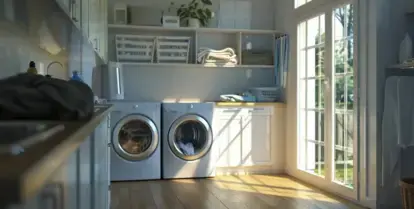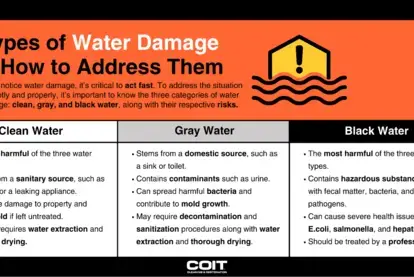
7 Clothes Dryer Safety Tips to Prevent Fires
Contact COIT for a professional cleaning!
Clothes dryers are a convenient household appliance, but they come with hidden dangers.
Each year, clothes dryers cause about 14,970 fires, 13 deaths, and 440 injuries, according to the National Fire Protection Association (NFPA).
Most of these fires start because of a simple issue: failure to clean the dryer properly.
With dryers now often placed in riskier areas like bedrooms and second-floor hallways, understanding and practicing clothes dryer safety is more important than ever.
In this guide, we’ll walk you through essential tips and maintenance practices to keep your dryer running safely.
Understanding the Risks
Lint Buildup
Lint is created when water is removed from garments in the dryer’s drum. While much of it is captured by the lint trap, some gets carried through the ventilation system and accumulates, reducing airflow and creating a fire hazard.
Signs of Restricted Airflow
- Hot Clothes: Clothes are very hot after a drying cycle.
- Extended Drying Times: The dryer takes longer to dry clothes.
Essential Dryer Safety Tips
1. Clean the Lint Trap
One of the simplest yet most crucial steps you can take to prevent dryer fires is to clean the lint trap after every load of laundry. Over time, lint can clog the screen, restricting airflow and increasing the risk of fire.
If the lint screen seems clogged, submerge it in warm water and scrub it with a bristle brush to remove stubborn lint.
2. Inspect the Vent System
It’s essential to periodically inspect and clean the vent system behind your dryer. Lint can accumulate in the ductwork, reducing airflow and creating a fire hazard.
Use a dryer lint brush to loosen built-up lint around the lint trap opening. Running the dryer on an “air only” cycle can help pull loose lint into the filter or blow it out the outside vent.
3. Check for Lint Buildup
Regularly check the exhaust vent system to ensure it’s not blocked or restricted. A blocked vent can cause the dryer to overheat and potentially start a fire.
Make sure the vent system is made of rigid or semi-rigid metal ducting material, as this reduces the risk of fire compared to flexible plastic or foil ducts.
4. Professional Cleaning
While regular maintenance is crucial, it’s also important to have your dryer vent and exhaust system professionally cleaned at least once a year.
A professional cleaning service can remove built-up lint and ensure your dryer operates safely and efficiently.
At COIT, we offer comprehensive dryer vent cleaning services to help you keep your home safe.
Contact COIT for a professional cleaning!
5. Don’t Overload the Dryer
Overloading the dryer can cause it to overheat and increase the risk of fire. It’s essential to follow the manufacturer’s guidelines regarding load size.
Smaller loads dry more efficiently and reduce the risk of overheating.
6. Avoid Running the Dryer Unattended
Never leave your clothes dryer running when no one is home or while you’re sleeping.
If a fire starts and you’re not around to address it immediately, the damage can be significant. Always ensure someone is present when the dryer is in use.
7. Inspect Gas Dryers
If you have a gas dryer, have it inspected regularly to ensure the gas line and connection are intact.
Gas leaks can pose a serious fire hazard, so it’s essential to have a professional check your gas dryer periodically.
Advanced Safety Measures
Install a LintAlert™ Dryer Safety Alarm
Installing a LintAlert™ Dryer Safety Alarm can alert you when airflow becomes restricted in the venting system.
These alarms are available at hardware stores and require professional cleaning of the dryer vents for proper calibration.
COIT’s LintAlert Protection Service
COIT offers a comprehensive LintAlert Protection Service, which includes a thorough cleaning of the dryer vent and the professional installation of a LintAlert Alarm. This service ensures your lint levels are safe and alerts you to future problems.
Contact us at 1-800-FOR-COIT to schedule your service today!
Detailed Maintenance Guide
To keep your dryer in optimal condition and reduce the risk of fire, follow these detailed maintenance steps:
Weekly Maintenance
- Clean the Lint Trap: After every load, remove lint from the lint trap. If the lint screen appears clogged, wash it with warm water and a brush.
- Inspect the Dryer Drum: Check the inside of the dryer drum for any signs of lint buildup. Use a vacuum or a soft brush to remove any lint.
Monthly Maintenance
- Check the Exhaust Vent: Inspect the exhaust vent outside your home to ensure it’s not blocked. Clear away any debris or obstructions.
- Clean Around the Dryer: Remove any lint or dust around the dryer. Keeping the area clean reduces the risk of lint igniting.
Annual Maintenance
- Professional Inspection: Schedule a professional inspection and cleaning of your dryer vent system. This service will remove any lint buildup in the ductwork and ensure your dryer operates safely.

Additional Safety Tips
Use the Correct Venting Material
Ensure your dryer vent system uses rigid or semi-rigid metal ducting material. Flexible plastic or foil ducts can sag, allowing lint to accumulate in low spots, which increases the risk of fire.
Keep the Area Around the Dryer Clear
Store flammable items like cleaning supplies, clothing, and paper products away from the dryer. A clear area around the dryer reduces the risk of these items catching fire.
Educate Your Family
Make sure everyone in your household understands the importance of dryer safety. Teach them how to clean the lint trap and what signs to watch for that indicate restricted airflow.
The Importance of Regular Maintenance
Regular maintenance of your dryer is not just about keeping it running efficiently; it’s also about safety.
By keeping the lint trap clean, inspecting the vent system, and scheduling professional cleanings, you can significantly reduce the risk of dryer fires.
At COIT, we’re dedicated to helping you keep your home safe. Our dryer vent cleaning services are thorough and reliable, ensuring your dryer operates safely and efficiently.
Conclusion
By following these essential dryer safety tips, you can protect your home and family from the risk of dryer fires. Regular maintenance, proper use, and advanced safety measures like the LintAlert™ Dryer Safety Alarm can make all the difference.
Remember, safety starts with awareness and action. Don’t wait for a problem to occur – take steps today to ensure your dryer operates safely.
For more information about LintAlert Protection and COIT’s other cleaning and disaster restoration services, call (800) – FOR-COIT. We look forward to scheduling your next service!
Additional Resources
For more information on clothes dryer safety, visit:
- NFPA - Dryer Safety
- Consumer Reports - Dryer Fire Prevention
- Jenkins Restorations - Dryer Fire Prevention Tips
And remember, no matter what – never leave your clothes dryer running when no one is home.
For more information about LintAlert Protection and COIT’s other cleaning and disaster restoration services, call (800) – FOR-COIT. We look forward to scheduling your next service!



